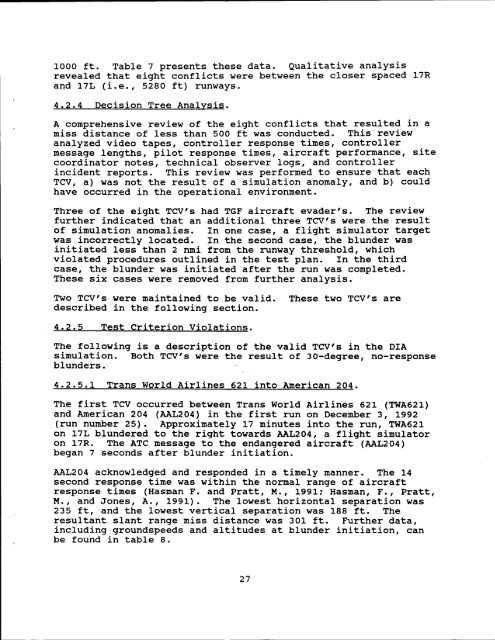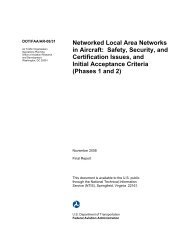Published Report (DOT/FAA/CT-94-36)
Published Report (DOT/FAA/CT-94-36)
Published Report (DOT/FAA/CT-94-36)
Create successful ePaper yourself
Turn your PDF publications into a flip-book with our unique Google optimized e-Paper software.
1000 ft. Table 7 presents these data. Qualitative analysis<br />
revealed that eight conflicts were between the closer spaced 17R<br />
and 17L (i.e., 5280 ft) runways.<br />
I :<br />
I i<br />
4.2.4 Decision Tree Analysis.<br />
A comprehensive review of the eight conflicts that resulted in a<br />
miss distance of less than 500 ft was conducted. This review<br />
analyzed video tapes, controller response times, controller<br />
message lengths, pilot response times, aircraft performance, site<br />
coordinator notes, technical observer logs, and controller<br />
incident reports. This review was performed to ensure that each<br />
TCV, a) was not the result of a simulation anomaly, and b) could<br />
have occurred in the operational environment.<br />
Three of the eight TCV's had TGF aircraft evader's. The review<br />
further indicated that an additional three TCV's were the result<br />
of simulation anomalies. In one case, a flight simulator target<br />
was incorrectly located. In the second case, the blunder was<br />
initiated less than 2 nmi from the runway threshold, which<br />
violated procedures outlined in the test plan. In the third<br />
case, the blunder was initiated after the run was completed.<br />
These six cases were removed from further analysis.<br />
Two TCV's were maintained to be valid. These two TCV's are<br />
described in the following section.<br />
4.2.5 Test Criterion Violations.<br />
The following is a description of the valid TCV's in the DIA<br />
simulation. Both TCV's were the result of 30-degree, no-response<br />
blunders.<br />
4.2.5.1 Trans World Airlines 621 into American 204.<br />
The first TCV occurred between Trans World Airlines 621 (TWA621)<br />
and American 204 (AAL204) in the first run on December 3, 1992<br />
(run number 25). Approximately 17 minutes into the run, TWA621<br />
on 17L blundered to the right towards AAL204, a flight simulator<br />
on 17R. The ATC message to the endangered aircraft (AAL204)<br />
began 7 seconds after blunder initiation.<br />
AAL204 acknowledged and responded in a timely manner. The 14<br />
second response time was within the normal range of aircraft<br />
response times (Hasman F. and Pratt, M., 1991; Hasman, F:, Pratt,<br />
M., and Jones, A., 1991). The lowest horizontal separation was<br />
235 ft, and the lowest vertical separation was 188 ft. The<br />
resultant slant range miss distance was 301 ft. Further data,<br />
including groundspeeds and altitudes at blunder initiation, can<br />
be found in table 8.<br />
27

















